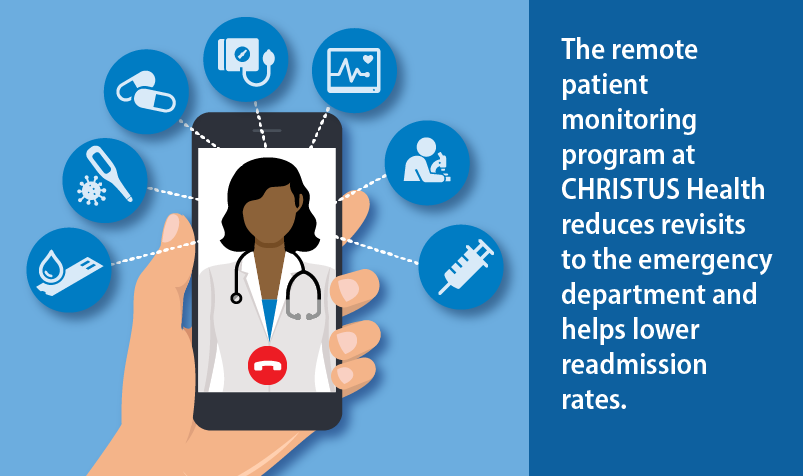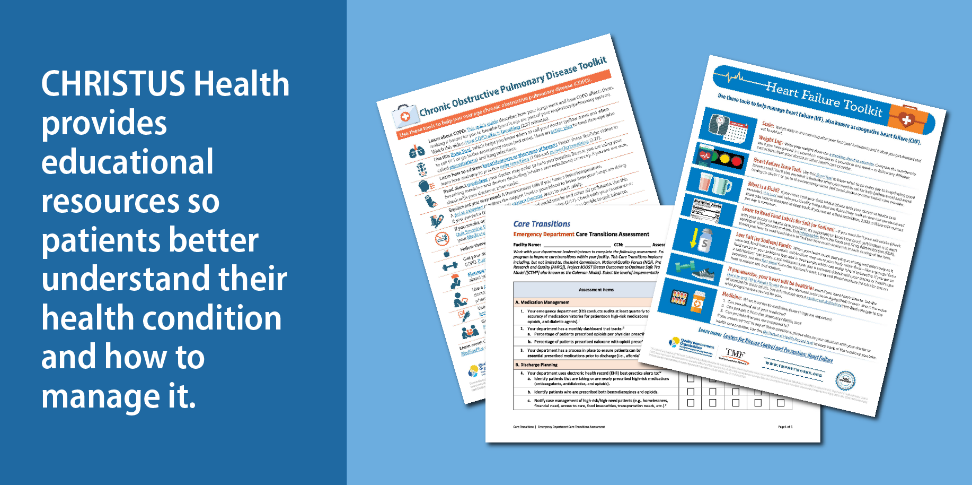Throughout the global pandemic, medical professionals in the U.S. worked tirelessly to provide quality health care to those infected with the coronavirus that causes COVID-19. Often, these health care workers faced significant challenges, such as staffing shortages and limited space to house sick people. At CHRISTUS Health Spohn Hospital (CHRISTUS Health), in Corpus Christi, Texas, the emergency department (ED) and hallways were swamped with new patients and those who returned to the ED or were readmitted to the hospital.
 Telemedicine gave the hospital a new way to meet pandemic-era challenges. CHRISTUS Health established a remote patient monitoring program (RPM) to help patients manage COVID-19-related illnesses at home. Through careful planning and a smooth implementation, the RPM gave patients the tools they needed to measure their oxygen levels, along with educational materials and resources. Patients were also encouraged to contact the hospital, using the phone number provided, if they needed assistance.
Telemedicine gave the hospital a new way to meet pandemic-era challenges. CHRISTUS Health established a remote patient monitoring program (RPM) to help patients manage COVID-19-related illnesses at home. Through careful planning and a smooth implementation, the RPM gave patients the tools they needed to measure their oxygen levels, along with educational materials and resources. Patients were also encouraged to contact the hospital, using the phone number provided, if they needed assistance.
Patients enjoyed the option of telehealth, which was provided at no cost to them. “Telehealth was comforting, a security link, if you will,” stated Roxanne Jenkins, RN, director of case management. Providers supported the program because it gave them “extra eyes and hands,” and allowed them to deliver needed patient care, virtually.
Seeing results
Using the RPM proved to be a resounding success. In one year, from August 2022 to July 2023, CHRISTUS Health’s ED revisit rates dropped by 31% and readmission rates saw a 58% decline.
 For Jenkins, the program’s effectiveness is best measured through the positive impact on patient health. Every patient served by the RPM got—and continues to get—individual attention. “The RPM parameters are patient specific,” she explained. CHRISTUS Health providers use an algorithm to analyze a patient’s current health status and establish their patient’s baseline. Providers monitor patients’ conditions via a smart phone, and patients report appropriate health data regularly. Providers use that information to determine if a patient’s health condition varies too much from his or her starting point. A worsening condition triggers an alert to a registered nurse, who then contacts the patient to assess their illness and intervene when necessary.
For Jenkins, the program’s effectiveness is best measured through the positive impact on patient health. Every patient served by the RPM got—and continues to get—individual attention. “The RPM parameters are patient specific,” she explained. CHRISTUS Health providers use an algorithm to analyze a patient’s current health status and establish their patient’s baseline. Providers monitor patients’ conditions via a smart phone, and patients report appropriate health data regularly. Providers use that information to determine if a patient’s health condition varies too much from his or her starting point. A worsening condition triggers an alert to a registered nurse, who then contacts the patient to assess their illness and intervene when necessary.
The RPM’s success has allowed CHRISTUS Health to expand it to support patients with congestive heart failure, pneumonia and chronic obstructive pulmonary disease (COPD). As a result, many more patients can get health care services remotely and are given the devices they need to collect their health data, such as pulse oximeters, thermometers, blood pressure monitoring equipment and scales for monitoring weight.
CHRISTUS Health provided educational resources, using material created by the TMF Quality Innovation Network, to help patients better understand their health condition and how to manage it. Quality improvement specialists from TMF Health Quality Institute worked with the facility to find and supply applicable resources to support the RPM’s expansion to cover different conditions. Patients have access to various toolkits, such as ones for COPD and Heart Failure. To improve health equity through language access, Spanish-speaking patients can view Spanish versions of resources, including the Heart Failure Toolkit in Spanish.
In addition to providing guidance to patients, the ED staff can also use the TMF Quality Innovation Network educational materials. For example, CHRISTUS Health can use the Emergency Department Care Transitions Assessment to evaluate care transition elements within the department. Upon completing the assessment, the department leadership team will be able to accurately pinpoint which elements need to be implemented or further developed to improve care transitions within the facility.
Continued expansion
Expanding the RPM was a first step toward reaching CHRISTUS Health’s goal to provide patients with a seamless continuum of care. In February 2024, CHRISTUS Health took another step and made the RPM available to patients leaving the hospital or skilled nursing facility (SNF) with home health services.
This addition to the program is especially helpful for patients who are anxious about maintaining their health care plan at home, on their own. “When in a medical facility, health care workers ensure that a patient’s needs are being met,” said Jenkins. When patients go home, they may not have that daily support, and “that’s when questions arise,” she noted. “Patients may be confused about what medications to take and the correct dosages, for example. Patients may need help with wound care or to be reminded about their medical appointments, and so on.”
So, CHRISTUS Health teamed up with the region’s home health agencies and asked home health caregivers to establish a relationship with patients before they are discharged. Home health caregivers were also asked to work with patients and create a care plan for home.
"The partnership should result in positive outcomes," said Jenkins. The expanded RPM, she added, “reflects our commitment to deliver high-quality care and ensure a seamless transition for our patients as they continue their recovery at home.”